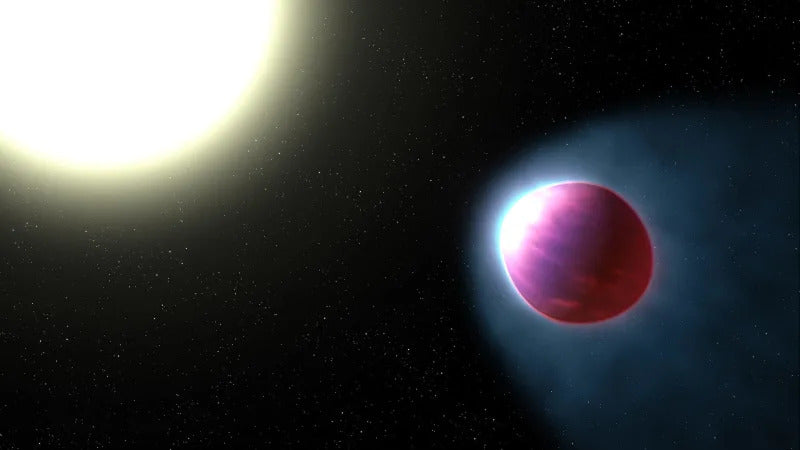
This Football-Shaped Planet Is Leaking Heavy Metal
This hot Jupiter is so close to its host star that gravitational forces are squeezing it into a football-like shape. Not only that, its temperatures are so extreme that heavy metal gases are escaping into space from the exoplanet’s atmosphere—a phenomenon never seen before until now.
Iron and magnesium gases are escaping the atmosphere of WASP-121b, a hot Jupiter located around 880 light-years from Earth, according to new researchpublished today in the Astronomical Journal.
WASP-121b is features a mass about 1.8 times that of Jupiter, and it’s very close to its host star, requiring just 1.275 days to make a complete orbit. At this distance, the gravitational forces are so intense that WASP-121b is on the verge of being torn apart. And that’s not hyperbole; this planet is perilously close to experiencing a tidal disruption, at which point the planet would collapse. Consequently, the planet is distorted, bearing the appearance of a football.
“The easiest way to understand it is like the ocean tides on Earth from the Moon,” David Sing, the lead author of the new study and an astronomer at the Johns Hopkins University in Baltimore, told Gizmodo. “In our case, the gravity from the Moon pulls on the oceans, so the ocean closest to the moon bulges out toward the Moon which is high tide. Similarly, the gravity is weakest on the opposite side of Earth from the Moon, so the ocean isn’t pulled as strongly so also creates a bulge on the opposite side of the Earth. So the Earth-Ocean system becomes distorted and a little bit ‘football shaped,’” he said.
A similar thing is happening on WASP-121b—but on a vaster scale. Sing said the part of the planet closest to the star is around 10 percent larger than it normally would be.
At the same time, intense radiation from the host star is heating WASP-121b’s upper atmosphere to temperatures exceeding 2,200 Kelvin (3,500 degrees Fahrenheit). Research from last year showed that WASP-121b is so hot that water molecules in the atmosphere are being ripped apart.
In the new study, Sing and his colleagues showed that the excessive heat in the upper atmosphere is also causing heavy metal gases to drift away from WASP-121b. The new research is the first to demonstrate this phenomenon, in which iron and magnesium from the lower atmosphere flows up into the upper atmosphere, where it stays in gaseous form owing to the high temperatures. From there, the heavy metal gases escape into space by clinging onto lighter hydrogen and helium gas, according to the new study.
“There have been heavy metals found in exoplanets before, and we also know they have escaping atmospheres,” Sing told Gizmodo. “However, most predictions haven’t included such heavy metals in their models and it was a big surprise to find the metals at such very high altitudes.”
Sing and his colleagues made the observations using the Imaging Spectrograph instrument on the Hubble Space Telescope. The researchers detected the spectra of magnesium and iron in near-ultraviolet as the exoplanet passed in front of its host star from our perspective here on Earth, an observing technique known as the transit method. Given the extreme conditions on WASP-121b, the scientists were trying to see if the escaping of heavy metal gases was indeed possible.
“We thought we had a chance of seeing heavier elements escaping. It’s so hot and so favorable to observe, it’s the best shot at finding the presence of heavy metals,” noted Sing in a Hubble press release. “We were mainly looking for magnesium, but there have been hints of iron in the atmospheres of other exoplanets,” to which he added: “The heavy metals are escaping partly because the planet is so big and puffy that its gravity is relatively weak. This is a planet being actively stripped of its atmosphere.”
During their analysis, Sing and his colleagues had to make sure the host star wasn’t contaminating their readings. Fortunately, they had access to data from the NASA TESS mission, which “gave us good constraints on how active the star is, which helped rule out stellar activity as a possible signal,” Sing told Gizmodo.
As for the fate of WASP-121b, Sing said it’s doomed; eventually, this hot Jupiter will be torn to shreds by its host star.
“Current estimates place that about 10 million years or so in the future, which in astronomy terms isn’t very long,” said Sing. “Over the next decade, astronomers are hoping to actively detect the planet’s orbit slowly decaying, at which point we’ll have a better idea of its true fate.”
Artist’s impression of WASP-121b.Image: Hubble Space Telescope
Autor: George Dvorsky
Tags: #metal #rock #music #heavymetal #metalhead #deathmetal #guitar #blackmetal #punk #metalmusic #thrashmetal #metalcore #band #hardrock #metalband
TURN THE DIAL TO METAL COLLECTION
MORE COLLECTIONS


















